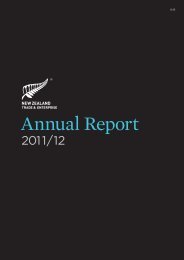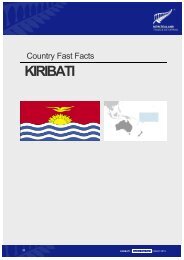Navigating China Guide (2012) - New Zealand Trade and Enterprise
Navigating China Guide (2012) - New Zealand Trade and Enterprise
Navigating China Guide (2012) - New Zealand Trade and Enterprise
Create successful ePaper yourself
Turn your PDF publications into a flip-book with our unique Google optimized e-Paper software.
What to wear<br />
Business attire<br />
Tips:<br />
• Dress formally for business occasions.<br />
• Check the weather from websites.<br />
• Generally, formal dress is a sign of respect. It’s also<br />
the safest option if you’re not sure what to wear.<br />
• For formal business in <strong>China</strong>, conservative suits are the<br />
norm for men <strong>and</strong> women. Ties are commonly worn.<br />
• A short-sleeved shirt without jacket or tie is acceptable<br />
in the summer for informal meetings.<br />
• Jeans are acceptable for men or women in a casual setting.<br />
Shorts are generally only worn for exercising.<br />
• If you’re not sure about what to wear, simply ask ahead<br />
of the meeting or dinner.<br />
Eating <strong>and</strong> drinking<br />
In General<br />
Tips:<br />
• If you are invited to a dinner, the protocol is that guests<br />
arrive right on time or a few minutes early.<br />
• If you are hosting be there in plenty of time to greet your<br />
Chinese guests – be prepared they may arrive up to half an<br />
hour early.<br />
• A business dinner is usually reserved for more serious<br />
business, for people who have a good business relationship,<br />
or to celebrate a deal.<br />
• Use similar protocols when arranging reciprocal dinners<br />
<strong>and</strong> lunches.<br />
Dinners <strong>and</strong> banquets<br />
Tips:<br />
• Dinners, including banquets, are normally held in a private<br />
room at a restaurant or hotel. Very senior people may be<br />
present at a banquet.<br />
• Dinners or banquets generally last for around an<br />
hour-<strong>and</strong>-a-half.<br />
• The serving of fresh fruit will mean it is the last dish, then<br />
the host will announce the dinner or banquet is at an end.<br />
• If you are the host, the Chinese guests will wait for you to<br />
signal the end of the dinner with a last toast or a few words.<br />
• Photo opportunities may follow at the end of dinner (if this<br />
is the first dinner with your Chinese counterparts).<br />
• The principal guest is expected to leave first followed by<br />
other guests. Prompt farewells are appreciated.<br />
• Alternatively, your host may invite you to a karaoke bar, night<br />
club or sauna. You may want to make a night of it. If not, tell<br />
them you have a delegation meeting or are tired after a long<br />
day, or that you will stay for a short while.<br />
• A typical Chinese dinner or banquet will consist of eight<br />
to 12 courses, served consecutively.<br />
• On formal occasions, each dish is served away from the table<br />
<strong>and</strong> individual portions placed before diners.<br />
• Some very interesting <strong>and</strong> potentially odd dishes<br />
– by Western norms – can be served.<br />
• Rice is generally more popular in the south, while noodles<br />
are preferred in the north.<br />
• If you are entertaining guests, remember most Chinese are<br />
not used to cheese or butter <strong>and</strong> lamb is not always popular,<br />
so consider omitting these items from the menu.<br />
• It’s important to accept dishes, there’s no compulsion to eat<br />
every serving. You can leave dishes you don’t want to eat<br />
to one side.<br />
Speeches <strong>and</strong> toasts<br />
Tips:<br />
• It is normal for the host to make a speech of welcome <strong>and</strong><br />
toasts at the beginning of the meal.<br />
• The principal guest may respond straight away, or choose<br />
to respond after a few courses have been served.<br />
• Chinese normally respond very positively if the <strong>New</strong> <strong>Zeal<strong>and</strong></strong><br />
delegation conclude their speech with a waiata.<br />
• Toasts are normally very short. It may include a simple<br />
welcome (or thank you) <strong>and</strong> a brief substantive comment<br />
on the visit.<br />
• Safe topics for toasts are friendship, cooperation <strong>and</strong><br />
mutual benefit.<br />
• Key message at the end of toasts may also include:<br />
– the success of the business cooperation<br />
– the friendship between the two companies<br />
– the friendship between the two countries.<br />
Seating<br />
Tips:<br />
• Dinners will normally be at round tables. A long table<br />
is used occasionally.<br />
• Dinner seating arrangements are generally pre-determined<br />
<strong>and</strong> indicated by name cards on the table/s.<br />
• If a long table is used, the guest of honour sits directly across<br />
the table from the host.<br />
• If you’re not sure where to sit because there are no name<br />
cards on the table, then a good strategy is to sit at a lower<br />
place <strong>and</strong> be invited up, rather than be asked to drop down<br />
a level.<br />
• Alternatively, you can wait to be seated.<br />
If hosting, the seating plan for a round table may look like<br />
the following:<br />
Interpreter<br />
NZ 4<br />
<strong>China</strong> 1<br />
NZ 1<br />
<strong>China</strong> 3<br />
<strong>China</strong> 4 <strong>China</strong> 2<br />
NZ 2<br />
NZ3<br />
NZ 5<br />
19
















